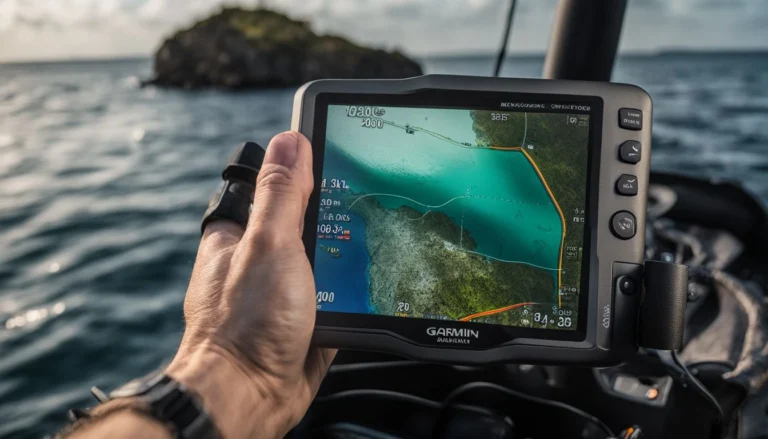How Do I Power My Garmin Fish Finder at Home?
Many anglers wonder how to use their Garmin fishfinders without being on the water. One interesting fact is that people often try creative DIY solutions, like using small 12V batteries or AC chargers at home.
Our guide will delve into secure and efficient methods to power up your fishfinder indoors, with step-by-step instructions.
Keep reading to become the tech-savvy angler who knows the ins and outs of marine electronics!
Key Takeaways
- You can power your Garmin fish finder at home by using a 12V battery or an AC charger that matches the device’s specifications. Make sure you connect and disconnect the positive and negative terminals correctly to avoid electrical hazards.
- A quick disconnect pedestal makes mounting and removing your Garmin fish finder easy, preventing damage to cables and connections while allowing for portability between home and boat setups.
- Download new maps for your fishfinder from the Garmin website to enhance navigation on the water. Always ensure your device is powered properly during this process with stable connections to prevent any data loss or interruptions.
- Keep safety in mind when powering your device at home; use only recommended voltage levels; monitor charging times to avoid overcharging; check cables for damage before use; keep away from water; and don’t expose batteries or chargers to extreme temperatures.
- With proper setup at home, you can update maps, plan fishing trips in advance, and maintain the performance of your Garmin fish finder so it’s ready-to-use whenever you decide to go out on the water.
Understanding the Garmin Fish Finder
Garmin Fish Finders harness the power of sonar to locate fish beneath your boat, providing a clear image of what’s happening under the water. These devices shoot sound waves into the depths, which bounce back when they hit objects like fish, giving anglers an almost x-ray-like view.
This technology transforms your fishing experience by acting as both a depth finder and a fish locator.
The screen displays detailed images, thanks to advanced marine sonar technology. It reveals structures where fish might be hiding, along with information about water depth and bottom contour.
Fish scanning equipment on these units comes in various forms: some offer simple black-and-white visuals, while others boast high-definition color displays that can differentiate between baitfish and gamefish targets.
As you navigate through waters unknown or familiar, this underwater sonar device becomes an indispensable tool for making every cast count.
Powering Your Garmin Fish Finder at Home
Transforming your home into a functional space for engaging with your marine electronics is straightforward; you simply need to replicate the boat’s power supply using accessible household tools and methods.
Discover how effortless it can be to enjoy the full capabilities of your Garmin fish finder without ever leaving dry land by harnessing the right adapters and techniques designed for safe indoor use.
Disconnecting the battery’s positive and negative terminals
Powering your Garmin fishfinder at home starts with safely disconnecting the power source. Here’s a straightforward guide to disconnecting the battery’s positive and negative terminals:
- Turn off all devices connected to the battery before starting, including your fish finder, to prevent any electrical mishaps.
- Find the battery you’ll be using; ClarkReehm suggests a 12V motorcycle battery as a dependable option.
- Identify the positive and negative terminals on the battery; typically, positive is marked with a plus sign (+) and a red color, while negative has a minus sign (-) and a black color.
- Use an appropriate wrench or pliers to loosen the nut on the negative terminal first; this reduces the risk of sparking.
- Carefully remove the cable from the negative terminal, ensuring that it doesn’t touch any metal parts of your workspace.
- Repeat this process for the positive terminal by loosening its nut and detaching its cable.
Using an AC charger
To power your Garmin fish finder without its battery, you can rely on a home AC charger. First, ensure you have the correct electrical charger that matches your device’s requirements.
Connect this power adapter to a wall outlet using a standard electric plug. Next, attach the charging cable from the adapter to your fishfinder’s power input. This method allows for safe and consistent electricity flow from your home power supply directly to your device.
Using an appropriate voltage converter is crucial if your household electric power source does not match the required input for the fish finder. A voltage converter will adjust the current accordingly, preventing any damage to your unit due to power discrepancies.
Always check that connections are secure and use only recommended cables and adapters designed for electronic devices like Garmin fish finders to maintain optimal performance while connected to a power outlet or household power socket.
Quick Disconnect Pedestal for Easy Installation and Removal
Getting your Garmin fish finder ready for action at home doesn’t have to be a chore, thanks to the quick disconnect pedestal. This handy accessory allows you to mount or remove your device with ease.
The design is straightforward: simply snap the unit into place on its base, and it’s good to go. When you’re done, press the release, and off it comes without any fuss. This feature not only saves time but also reduces wear and tear on cables and connections.
Having this type of pedestal means less time tinkering with tools and more time preparing for your next fishing adventure. It’s perfect for anglers who need a portable power solution or want the flexibility to move their depth finder from boat to home without complications.
With easy installation as a top priority, even those new to using fish finders can set up their system quickly and get right down to business planning routes and marking hotspots on maps, which conveniently leads us into downloading maps for your Garmin fish finder.
Downloading Maps for Your Garmin Fish Finder
To download maps for your Garmin fish finder, hook it up to a power source at home; this can be done using the same methods discussed earlier, like a laptop charger or battery. Then connect the device to your computer with an Ethernet cable or an appropriate converter, if needed.
Visit the Garmin website and choose from an array of detailed marine charts and inland maps tailored for fishing and boating. Select the maps that best cover your favorite fishing spots or new areas you plan to explore.
Follow the simple prompts on screen for installation after purchasing. Your Garmin fish finder will now have all the necessary data loaded for your next adventure on water, guiding you with precision to prime fishing locations and underwater structures where fish like to hide.
With updated maps, expect enhanced navigation confidence, ensuring you spend more time casting lines than searching for spots.
Safety Precautions When Powering the Fish Finder at Home
Ensuring the safety of your Garmin fishfinder while powering it at home is essential. Following these guidelines will help prevent potential hazards.
- Confirm that your power source aligns with the fishermen’s requirements. Check the specifications for the proper voltage and amperage to avoid damaging your device.
- Always adhere to the manufacturer’s instructions for powering your fishfinder. Using incorrect settings can lead to malfunctions or even pose a fire risk.
- Employ the correct voltage when connecting your fish finder to a power source. Devices typically operate on a specific voltage range, which you need to match with your home supply.
- Avoid overcharging the fish finder by monitoring its charging time and using a timer if necessary. Overcharging can reduce battery life and effectiveness.
- Ensure you have a stable and secure power connection. A loose or fluctuating power source can cause interruptions or damage to the fishfinder.
- Provide adequate ventilation around the charging area to prevent overheating. Devices that stay cool during charging are less likely to encounter problems.
- Inspect all cables and connections for wear or damage before plugging them in. Replace any frayed wires or damaged parts immediately.
- Disconnect the device promptly after it reaches full charge. Prolonged connection without supervision increases the risk of electrical mishaps.
- Keep water away from all electrical components during setup and charging procedures. Dry your hands thoroughly before handling plugs or switches.
- Store batteries and chargers away from direct sunlight and extreme temperatures when not in use, as these conditions may compromise their integrity.
Conclusion
Jump-starting your Garmin fishfinder at home doesn’t require complicated setups or expert knowledge. With the right power source, such as a 12V battery or an AC-to-DC converter, you can easily bring it to life in your own space.
Remember to handle all electrical connections with care and follow manufacturer guidelines for safety. Enjoy exploring maps and planning new adventures from the comfort of home, ensuring your next fishing trip is well charted before you even hit the water.
Your marine electronics are now ready for action, anytime you are!
FAQs on Powering Garmin Fish Finders
Gary Burrell
Born in 1989, Gary Burrell is an Electrical Engineering graduate from the University of Tennessee. With 20+ years of experience, he has transitioned from engineering roles to becoming the Chief Content Editor. Gary’s unique blend of technical knowledge and editorial expertise has made him an essential figure in content creation, ensuring clarity and accuracy. His journey from an engineer to an editor showcases his adaptability and commitment to continuous learning.




